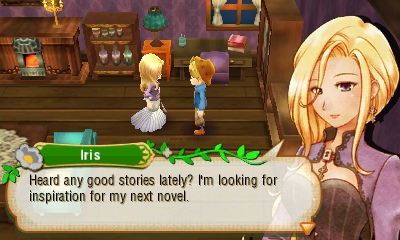Howdy, folks!
Here on the Story of Seasons localization team, farming’s been our life for the past several months. We’ve edited our way through mountains of text on cow care, seasonal fruits, beekeeping, market values, and all the little heartfelt moments that make Oak Tree Town come alive. (We’ve also edited about a thousand variations on “I like your sweater” and “My favorite color is red,” as part of the NPCs’ incidental text, but hey, all part of the job.)
Outside of work, farming references have seeped into our collective consciousness, to the point where we’ve spent our breaks swapping jokes and stories about our made-up characters Croptimus Primerib and Maize-a-tron, leader of the evil Decepticorns. Transfarmers: More than reaps the rye!

Anyway, now that we’re done with the translation and editing, what’s left? Mostly QA at this point. With the English text implemented into the game, three or four of us are playing through different sections every day to make sure the text (1) appears correctly, without overrunning the text borders or calling the wrong variable, and (2) fits the context of the scene.
You’d be surprised how often the latter comes up. When you’re editing a game’s script, which usually comes to you as a batch of Excel files (sometimes with a Japanese build of the game handy for reference, but only sometimes) it’s not always easy to tell where in the game a particular line will appear, which other lines will appear around it, or even, at times, what the line is referring to. When you finish that first editing pass, what you’ve got is a revision of a translation of the original writer’s best guess as to how the game would eventually look. So you’re going to have some bugs no matter what, at least at first, and once the QA phase rolls around, that’s when it becomes your job to catch them.
Just yesterday, we logged a bug where Elise told the player, “Ugh, that tasted positively horrendous!” and then immediately added, “That was delicious!” Other times, we’ve seen townspeople say “Good morning” after sundown, or say “Get some sleep” right after dawn, or shout “You there!” to the person who’s been standing right in front of them the whole time.

We’re fixing those as we go, of course. We’re a small team, but we’ll get through the rest of the game’s text in time and make sure everything’s where it needs to be. On a side note, this whole process has made us appreciate all the hard work our predecessors put into the series, with an even smaller team than we have.
Besides all of the above, the QA process is also about preserving each character’s voice, making sure they speak in a consistent manner from scene to scene. That’s doubly important in a non-linear game like this one, where the script files aren’t always in any particular order, and where multiple localizers sometimes have to take turns writing the same character. Bringing out the characters’ voices is the most critical part of a strong localization; ideally, a player should be able to look at any one of a character’s lines, with no portrait or name tag, and know on the spot which character said it. That’s part of how players get to know the characters, part of how they connect and bond with them, and if you can build those bonds as a writer, your players will remember the characters fondly long after they’ve finished playing the game.

Fortunately for us, the developers gave us plenty of great material to work with. Oak Tree Town is full of colorful inhabitants; the flamboyant Dr. Marian, the classy gentleman Klaus, freewheeling country boy Fritz, sweet old Eda, clinical nurse Angela, the bubbly, bumbling weathergirl Lillie, and the brilliant but awkward Licorice, to name just a few. Our job at this point is to make sure each character’s personality pops off the screen in just the way the game’s makers intended. And on that note, I’d better get back to it.
Tractorbots, transfarm and roll out!
~Ryan

